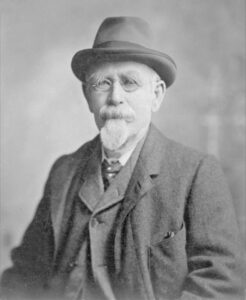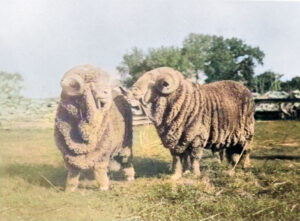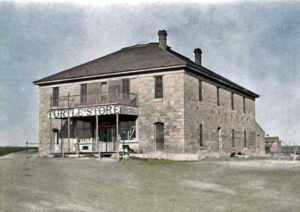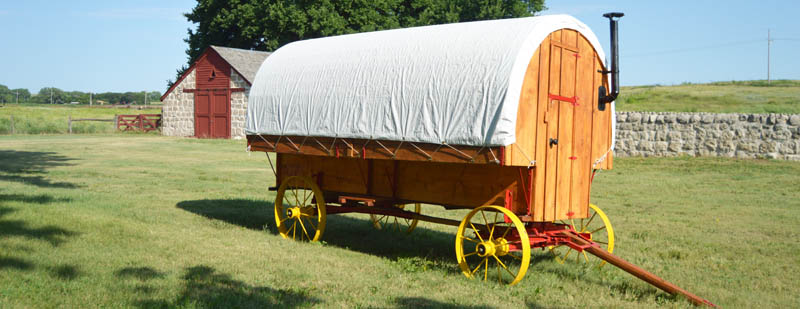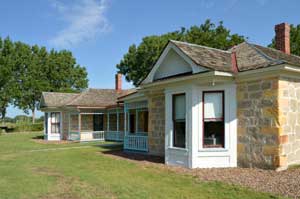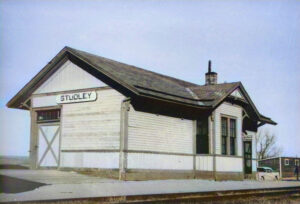
Studley, Kansas Grain Elevator, and Silos, courtesy of Google Maps.
Studley, Kansas, is a tiny unincorporated community in Valley Township of Sheridan County. It is also identified as an extinct town because it no longer has a post office.
First called Skelton, after the Skell River in England, this was a British settlement founded by Abraham Pratt in 1878 after he arrived from England. When he found a place he liked, he filed for a 160-acre homestead just south of the South Fork of the Solomon River. On his homestead, he initially built a “dug-out” of sod, stone, and wood.
Pratt, an ex-sailor, had also been a businessman, owning at least two pubs, a liquor mercantile, and a bottling works for carbonated water. He was soon joined by his two sons, a half-brother, and two nephews of friends. In the following years, Abraham Pratt would serve as the postmaster, the township’s Justice of the Peace, the lumberyard owner, a part-time farmer and sheepman, and an insurance salesman.
The first settlers in the community were sheep ranchers from England who began raising sheep. The settlement comprised middle-class Englishmen, unlike the other British communities of Victoria in Ellis County and Runnymede in Harper County. The other two settlements were founded by the sons of well-to-do English families, known as the “Remittance Men,” because they relied on their families for monetary support. Eventually, these men returned to England.
Not only did the community have an English name, but early settlers retained their British traditions, such as having “tea” in the afternoon, celebrating various British holidays, and subscribing to London’s Daily Mirror to stay current on the homeland news.
The first women in the settlement arrived in 1882 when the George Pratt family (no relation to Abraham) came to Studley with their daughters.
In 1885, the Frederick Turtle family came from England and built a small general store with a drug store.
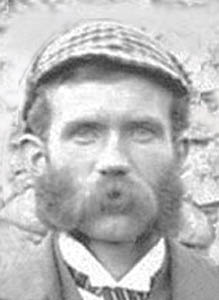
John Fenton Pratt.
Jennie Place, the childhood sweetheart of John Fenton Pratt, Abraham’s oldest son, came in 1888, and she and John Fenton Pratt were married on December 30, 1888. Soon afterward, John Fenton Pratt began building the Cottonwood Ranch west of town, incorporating English architecture into his home. Today, the Cottonwood Ranch is a Kansas Historic Site.
The Lincoln-Colorado Railway (which became part of the Union Pacific Railroad) came through the area in 1888 and opened a station. At that time, another town called Carll was established just east across the Graham-Sheridan County line.
A post office was opened in Skelton on March 21, 1889.
Confusion prevailed, with Carll and Skelton essentially being in the same place but having separate names. In late 1893, the U.S. Postal Service, probably in agreement with the railroad, demanded a name change so that both towns, Carll and Skelton, would share the same name. Abraham Pratt, still the postmaster, officially changed the name of the two hamlets to Studley, after Studley Royal Country Park near Ripon, England, on December 4, 1894.
The English who settled in Studley stayed in Kansas and learned to live with and work in the difficult conditions Mother Nature threw their way.
Fenton Pratt sold all his sheep by 1904 amid falling wool prices and a growing Kansas cattle industry.
In 1910, Studley had a population of 75.
In its heydays, Studley had a church, a school, a bank, a hardware store, two grocery stores, a blacksmith shop, a lumberyard, a post office, two livery stables, two saloons, a creamery, a barbershop, a restaurant, an implement dealership, and on its western outskirts a grain elevator in conjunction with the railroad’s depot and a stockyard for shipping livestock. At one time, a community center/dance hall was a prominent attraction where dances were held almost every Saturday night. During Prohibition, this place was a magnet for social interaction as well as for “bootleggers” to distribute their illegal adult beverages. One old story was that if the bootleggers were forewarned of a visit by the Sheridan County authorities, all they had to do was walk across the street into Graham County and be out of the legal jurisdiction of the Sheridan County law enforcers.
By 1936, Fenton Pratt still owned 80 acres of the land that held the house and outbuildings, some pasture, and the cropland south of the highway. When he died in 1937, his estate provided for his family. His wife, Jennie, and his daughter, Hilda, continued to live on the ranch. Elsie married and moved to Manhattan in eastern Kansas.
By 1939, Studley had a population of about 100. Afterward, like many small western Kansas communities, its population declined.
The community’s grade school closed in the 1960s as part of the state unification plan, and its last grocery store closed in the 1970s.
In 1982, the Kansas Historical Society purchased 23 acres of the Cottonwood Ranch property, which was listed in the National Register of Historic Places the following year. The outbuildings were badly deteriorated. Beginning in 1986, extensive restoration work was undertaken. Roofs were replaced, stone walls rebuilt, two-thirds of the shearing shed reconstructed, and stucco removed from the rear exterior of the house. Today, a garden and trees surround the stone Victorian-style residence. The State Historic Site is just a half-mile west of Studley on the north side of the highway.
Studley’s post office closed on September 24, 1994.
After 110 years, the 99-mile Plainville-Colby branch of the Union Pacific Railroad, which passed through Studley, was abandoned in 1998.
By the early 21st century, Studley’s population had dropped to 33.
Studley’s church was eventually “discontinued.” The local cooperative, created to meet all of the agricultural needs, has been consolidated and purchased by an area corporation, but it still maintains a service station and grain elevator.
Today, the community is served by the Hoxie, Kansas Unified School District 412.
Studley is approximately 16 miles east of Hoxie along U.S. Route 24, bordering Graham County.
©Kathy Alexander/Legends of Kansas, February 2025.
Also See:
Extinct Towns of Sheridan County
Sources:
Blackmar, Frank W.; Kansas: A Cyclopedia of State History, Vol I; Standard Publishing Company, Chicago, IL 1912.
Federal Writers’ Project of the Work Projects Administration; Kansas; A Guide to the Sunflower State; 1939.
Historic Marker Database
Kansas Memory
Solomon Valley Highway 24 Heritage Alliance
Wikipedia

